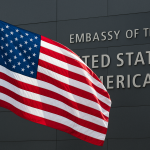Situated on the banks of the Sabarmati River, Ahmedabad has developed into one of the most important economic and industrial hubs within India. It is the largest city in Gujarat State with an urban population of 6,357,693 at the 2011 Census, making it the 7th most populous city in India. The city was the former capital city of Gujarat and ranked third in Forbes’ list of fastest growing cities of the decade in 2010, having grown by 25% since the 2001 Census.
Ahmedabad (also pronounced as Amdavad in the Gurati dialect) was founded in 1411 by the Sultan Ahmad Shah I as Ahmadabad, although records of settlements on the banks of Sabarmati can be traced back to the 11th century. The new town was fortified and made capital of the Gujarat Sultanate until falling firstly to Mughal rule in 1573 and later to the Maratha Empire in 1758, before the British East India Company took over the city in 1818. Following the end of British rule and the partition of India in 1947, several Hindu migrants headed to Ahmedabad from Pakistan, helping to swell the city’s population to well over half a million.
Leaders in Higher Education
During the years that followed Indian Independence, Ahmedabad became home to a large number of educational institutions and industrial research facilities. In 1960, the new state government established what has evolved into Science City in the Hebatpur district of Ahmedabad, promoting the importance of science and technology and aiming to draw more students towards education in science. Then in 1961, the Indian Institute of Management Ahmedabad (IIMA), was founded with the proactive support of the governments of India and Gujarat, prominent local industrialists, the Ford Foundation and the Harvard Business School. The IIMA has been consistently ranked as the premier business management school in India and also ranks within the top 30 of the Financial Times Global MBA Rankings with a three-year average rank of 28th (2016-2018).
By the time of the 1961 Census, Ahmedabad’s population exceeded 1.1 million and the city had been chosen as the capital of the new Gujarat state following the partition of the State of Bombay in 1960. Since then, the city has been successfully attracting students and young skilled workers from the rest of India and the urban population has swelled accordingly.
A thriving city economy
Ahmedabad used to be known as ‘The Manchester of the East’, being home to some of the oldest textile mills in India. Today it is still the second highest producer of cotton in the country and the largest supplier of denim.
The Ahmedabad Stock Exchange, dating back to 1894, is the second oldest in the country and the city is still the financial centre of Gujarat State, even though the decision was taken in 1970 to move the state capital to the all-new Indian designed city of Gandhinagar, situated 26 kilometres north of Ahmedabad.
But it’s not just the Textiles Industry that’s driving Ahmedabad’s economy today. The IT sector has developed rapidly, with Tata Consultancy Services (TCS), one of India’s largest companies and the world’s 2nd largest IT services provider, has a campus in Ahmedabad. The automobile industry is also making giant strides into Ahmedabad with Peugeot, Ford and Honda among those establishing manufacturing facilities.
Many of India’s top pharmaceutical companies are headquartered in Ahmedabad, including Zydus Cadila Healthcare and Torrent Pharmaceuticals. In addition, the success of the Ahmedabad-based Nirma group of companies is a true rags-to-riches entrepreneurial story, from a one-man operation doing door-to-door selling of detergent powder door-to-door to domestic housewives in 1969, to becoming the largest detergent brand in India within three decades with a market share of 38% and the second largest soap brand.
Award-winning infrastructure
The growing population has brought about a boom in construction projects and the creation of new housing, parks and transport systems. Following four years of feasibility studies, urban planning and development work, Ahmedabad’s award-winning Bus Rapid Transport System (BRST) was officially opened to the public on 14th October 2009 and now covers 125 kilometres across 12 routes and some 250 buses servicing 149 stations as at June 2018.
In future, it is intended that the BRTS will be integrated with the Ahmedabad Metro, or Metro-Link Express for Gandhinagar and Ahmedabad (MEGA) as it is also known. Initial feasibility studies for the mass-transit rail system were drawn up in 2003 by the Gujarat Infrastructure Development Board and approved by the Central Government in 2005, but later abandoned to give priority to the BRTS and suburban railway projects. But in 2008, the plans were revisited and construction officially started in 2016 for two routes, one being an East-West corridor of 21.16 km length and the other a North-South corridor of 18.87 km, totalling 40.03 km of which 33.50 km will be elevated and 6.53 km will be underground. The first trial runs are due to start early in 2019 and operation is due to start by 2020.
Now, with a well-developed infrastructure with several shopping malls and leisure entertainment complexes, Ahmedabad has become one of the nation’s most preferred real estate investment locations. The city is home to many museums and monuments and boasts a rich architectural heritage from various different cultures, ranging from classical Indo-Persian through European colonial styles to the modern skyscrapers and parks being developed by the Ahmedabad Municipal Corporation (AMC). The Times of India named Ahmedabad as the best of India’s cities to live in following an exclusive opinion poll conducted by the leading market research agency IMRB during 2011.
Bringing life back to the waterfront
Although Ahmedabad has 6 zones constituting 64 wards, the city is effectively divided into two parts by the Sabarmati River. The Eastern part comprises the old city, with crowded streets, street food markets, packed bazaars and numerous places of worship. The old walled city of Ahmedabad was proclaimed as India’s first UNESCO World Heritage City in July 2017. The Western side is more modern, having been developed during the colonial period, and includes the main industrial and business areas.
Two main bridges connect the old with the new – Ellis Bridge which was constructed in 1895 and the more modern and larger Nehru Bridge, dedicated to India’s first prime minister Jawaharlal Nehru. The city also has two main lakes – Vastrapur Lake in the western part of the city and Kankaria Lake in the south eastern part – both of which are surrounded by gardens and public walk-ways for exercise and recreational pastimes.
The AMC has also been developing the Sabarmati Riverfront for several years to improve the local environment and sanitation and it has so far reclaimed around 200 hectares of land of which over 85% is to be used for public recreational parks, sports facilities and gardens. Construction work started in 2005 and the first phase was completed in 2014, giving a two-tier pedestrian promenade 11 kilometres in length along both the east and west banks with many environmentally-friendly facilities and platforms at regular intervals to host organised cultural activities.
Vegan delights
But no visit to Ahmedabad would be complete without a tour of the old city and a walk around the historic city square of Manek Chowk. In the morning it operates as a vegetable market and in the afternoon it becomes a jewellery market, reputedly the second biggest in India. But in the evenings from around 9.30pm until well into the night, it transforms into a bustling street food market with a wide variety of snacks including desserts and ice cream. Gujarati food is primarily vegetarian and Ahmedabad claims to be the largest vegan city in the world. Did you know that the world’s first all-vegetarian Pizza Hut restaurant opened in Ahmedabad? But for a true taste of local cuisine, the Gujarat Thali is especially recommended!
[su_row][su_column size=”1/2″ center=”no” class=””]
Area: 464 sq. km
Location: 23.03°N, 72.58°E
Altitude: 55 metres above sea level
Average high °C:Feb 31°, Mar 35° (Year 34°)
Population: 8.1 million (2017 estimate)
Languages: Gujarati, Hindi and English
Main industries: Pharmaceuticals, Textiles,
Construction
City GDP: $68 billion (2017 estimate)
Time Zone: GMT +5.30
[/su_column]
[su_column size=”1/2″ center=”no” class=””]
Gujarat State quick facts
Gujarat is known as “The jewel of the East”:
The westernmost province of India
Birthplace of Mahatma Gandhi
Area: 196,024 sq. km
Coastline of 1,600 km – the longest sea shore of all Indian states
Population: 67.2 million (2017) – the 9th most populous Indian state
One of the most prosperous Indian states:
Nominal State GDP $230 billion (2018 estimate) – the 3rd largest state economy of India’s 29 states
Average GDP growth rate of 14% (2010-2017) – 7th fastest growth
GRDP per capita of $2,200 (2017)
Lowest unemployment rate of all India’s states (2015-16 report)
Gujarat’s residents represent 5% of India’s total population but hold over 30% equity of all Indian stocks in the share market.
[/su_column][/su_row]




